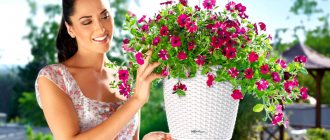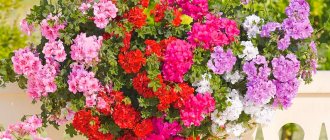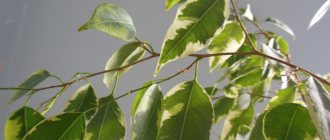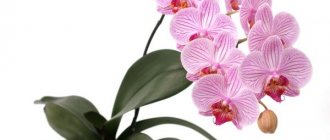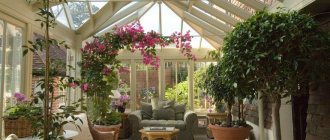Ampel plants, or ampels (derived from the German word die Ampel - a hanging flower vase) are ornamental crops grown in hanging pots and cache-pots. It is very easy to understand what ampelous means: such flowers have long, flexible stems that need support to grow in a given direction or go down in the form of a waterfall. In semi-ampeloid flowers, the shoots first stretch upward, forming a massive cap, and then begin to bend and hang down.
Features and advantages of hanging plants
A characteristic feature of the plants is a flexible stem that needs support: the flower curls upward along special nets or stands. If there is no support for the shoots, the pots are installed or suspended at the required height.
Flower wall made of ampelous Viola
Some plants are used as a ground cover crop, planted in open ground. However, this method does not reveal their true beauty.
The use of this type of plant is not limited. They are grown:
- as home interior decoration or on balconies;
- to create coziness in summer cottages by hanging flower pots near verandas and gazebos;
- in greenhouses, botanical gardens;
- for improvement of public places (parks, squares, train stations).
Advantages of growing hanging plants:
- Mobility. The issue of changing the location of the flower is resolved instantly: just move the pot to the right place.
- A variety of varieties to create picturesque compositions.
- Space saving. Flowers do not need to look for free space on the windowsill or shelf. When suspended, they will take up space, like a wall painting.
- Easy care in the form of regular watering and good lighting.
- Rapid growth and flowering throughout the warm season.
- Growing in urban environments. The lack of a summer cottage is not a reason to give up gardening: plants can be grown in pots on the balcony, giving it an unusual look.
Ampelous unpretentious flowers for the garden
What are ampelous plants and ampelous annual flowers?
Improper care or unsuitable weather can adversely affect the growth of ornamental plants. Ampelous, unpretentious flowers for the garden are very highly valued. They are able to grow both in good light and in the shade, withstand temperature changes and lack of fertilizers in the soil. Of course, you need to take good care of each flower.
The most unpretentious flowers:
- bacopa;
- nasturtium;
- petunia;
- bidens;
- ferulolate sequence;
- all succulents.
Nolan
What plants are suitable for hanging cultivation?
Colorful ones are ideal for ampel growing. unpretentious plants with graceful leaves. Landscape designers choose ampels that can grow upward, curl along a support, or hang in a cascade from an elevation.
A novice gardener should remember some features of growing hanging plants in the garden:
- Flower arrangements should be placed so that you can walk freely around the garden.
- It is advisable to change hanging pots periodically.
- Ampelous plants can grow both horizontally and vertically.
Campanula
Types of hanging plants
Among the variety of varieties, three groups of hanging plants are distinguished.
Succulents
Ampelous unpretentious perennial flowers for the garden
These include Rowley's ragwort, sedum, whip-shaped dysocactus, etc. These plants are valued for their hardiness and minimal care. The succulent shoots hanging from the pot are a heavy mass, so the flowerpot must be very stable or firmly fixed.
Important! Succulents love diffused light and humid air. They do not tolerate heat or excessive moisture.
Blooming
Representatives of this variety: fuchsia, aimenes, violet, etc. These are lovers of bright lighting, but not direct sunlight, heat, high humidity and regular watering.
The base of the roof of the house was decorated with flowering hanging plants - fuchsia
Decorative foliage
These include tradescantia, begonia, crested chlorophytum, etc. Shade-loving plants. For the bright color of the leaves they need fertile soil. Watering is carried out only after the soil has completely dried.
What plants are suitable for hanging cultivation?
Ampel plants for home and balcony
Colorful, beautifully flowering plants with a large hat or long shoots falling from flowerpots are ideal for hanging cultivation.
Among the succulents, the most popular are:
- Sedum Morgana, or sedum. Growing is possible at home, in the garden. Fleshy cone-shaped leaves form massive lashes. Moisture accumulates inside the shoots, and therefore it tolerates drought well. This thrifty flower is suitable for busy people who are away from home for a long time. It blooms with small reddish flowers.
- Godson Rowley. People call it green pearl for its beady leaves strung on a thread - a thin stem. Flower growers grow ragwort both at home and in the open ground. Its stems reach up to 2 m. It blooms with white flowers, similar to dandelion, but the plant is valued for its foliage.
- Disocactus braided. A cactus with hanging spiny stems, reaching 1.5 m in length and 2 cm in thickness over five years of cultivation. In spring it blooms profusely with large pink tubular buds.
Flowering hanging plants have won the love of gardeners with their variety of colors, abundant flowering and unpretentious care.
- Fuchsia. The ampelous variety has thin stems that form a lush crown cascading down. Unusually shaped buds can have different colors.
- Aimenes. Perennial with a winter dormant period. The leaves are oval, pubescent. The buds are shaped like a funnel with five blades. Abundant and lush flowering with all the colors of the rainbow makes the plant a universal favorite.
- Violet, or viola. The flowers are similar to field pansies, only larger. Planted both in pots and in open ground.
Examples of decorative deciduous ampelous flowers:
- Tradescantia. It is a creeping, creeping shoot with oval leaves densely located on them. The color of the leaves is varied. There are varieties where one side is usually green, the other side is burgundy. Also some have white, pink stripes. Blooms with large white and pink flowers.
- Begonia. A flower with asymmetrical leaves and lush red blooms.
- Chlorophytum crested. The bush has long green leaves 3 cm wide with a white stripe in the middle. Shoots hang from the middle, on which daughter bushes are formed over time, overall representing an original cascade.
Tradescantia, thanks to its unusual colors, has not lost its popularity for a long time.
Popular garden hanging flowers for flowerpots: names, brief information
Both flowering and herbaceous varieties are suitable for outdoor decoration. They can be combined with each other, with other colors, to create original multi-colored or monochrome compositions. Sometimes one beautiful hanging hanging flower is enough to radically transform the space.
Verbena
Ampelous forms of verbena are grown as an annual. They are very decorative, bloom until late autumn, resistant to temperature changes, and unpretentious. Hanging stems reach a length of 30-60 cm, bright flowers have a variety of colors. Propagated by seedlings and seeds.
Popular varieties:
- Empress Peach – cream-colored inflorescences densely cover long (up to 50 cm) shoots, blooms all summer;
- Estrella Voodoo Star – stems of medium length (up to 40 cm), red and white inflorescences;
- Imagination – long stems (up to 50 cm), large inflorescences of blue-violet shades densely cover a voluminous fluffy bush;
- Tapien – lush bush, corymbose inflorescences, different colors, white flower core;
- Tiara Red Impr - inflorescences of an unusual red-carmine color, blooms for a long time, and is characterized by rapid growth.
After flowering, dead inflorescences must be cut off so that they do not spoil the appearance. Be sure to make drainage holes in the container - if there is excess moisture, the roots will rot.
Viola
Ampel violas are annuals, distinguished by their spherical (height about 20 cm) bush shape, large monochromatic or variegated flowers (d≈5 cm), and small oval leaves. At first the shoots stretch upward, but after flowering begins they gradually fall down. They bloom from spring until frost.
The most popular varieties:
- Waterfall mix F1 – stem length is about 40 cm, petals are white, yellow, lilac, purple, high resistance to cold;
- Pearl Waterfall - white and purple flowers form a cap 30 cm high, blooms from spring to late autumn;
- Black waterfall - shoots about 30 cm long, flowers (d = 5 cm) of a rich purple hue look beautiful against the background of bright greenery, blooms from spring to autumn both in the sun and in a semi-dark place;
- Summer wave purple - long stems (up to 75 cm), flowers (d=5-6 cm) of purple shades;
- Wonderfall Yellow Wing - shoots up to 50 cm long, the edges of the petals are red, cold-resistant, blooms 2.5 months after planting the seeds.
Propagated by seeds. The seedling method of cultivation allows for early flowering. For abundant flowering, certain conditions must be met: sufficient light, temperature conditions, good soil. The pot can be kept at home until positive temperatures are established, then taken outside.
Bacopa or Sutera (Bacopa, Sutera)
An herbaceous ground cover, when grown in pots, long thin stems covered with small elliptical bright green leaves hang beautifully to form a lush bush. The flower is bell-shaped, small.
Varieties:
- Bluetopia – thin stems, up to 30 cm long, form a wide bush, olive-green leaves, blue, lilac flowers;
- Olympic Gold – stems (40-60 cm), thin, finely toothed oval leaves, with a golden tint, white flowers;
- Scopia Double Blue - leaves are fleshy, shoots up to 40 cm in length, the flower is large, with pink petals.
Flowering is wavy - the setting and opening of buds occurs almost simultaneously; after flowering, the buds fall off, and new ones immediately grow. They take cuttings well and can overwinter indoors.
Bidens or cultivated string (Bidens ferulifolia)
In cultivation, bidens is an annual, in nature it is a perennial, so varietal queen cells are well stored in winter. It goes well with other, similar growing conditions, container flowers (lobelia, blue petunia, purple viola, etc.). If you sow seeds for seedlings in mid-April, then in the second half of June flowers will appear and will delight you until the cold weather.
Common varieties:
- BeeDance Painted Red - distinguished by bright large flowers, the yellow petals at the core are red or have reddish stripes at the top;
- Golden ball - strong, branched shoots (up to 80 cm) form a voluminous spherical bush, flowers (d = 4 cm) are golden or light red;
- Taka Tuka is a low bush (30-40 cm), the flower petals are bright yellow, the core has richer shades.
The stems tolerate pruning well, so you can form bushes of different sizes. Bidens looks great in combination with other hanging flowers, and you can create original compositions from flowerpots and flowerpots of different sizes.
Lobelia (Lobelia richardii)
The ampelous lobelia has longer and stiffer stems than the hedgehog lobelia. Designed specifically for hanging baskets and flowerpots. Propagated, like all hybrid forms, by cuttings. Flowering is wavy; pruning is required after the first wave. Demanding about soil and watering.
The best varieties:
- Curacao Blue White Eye – blue petals with a white eye;
- Curacao Busket White Evol – white flowers;
- Techno Heat Trailing Light Blue – flowers of a beautiful sky blue hue with a white eye;
- Red cascade - stems (up to 50 cm) are thin, strong, flowers are small (d = 2 cm), blooms from early summer until frost, resistance to cold is average;
- Blue cascade - a 25 cm tall bush literally strewn with small (1 cm) blue flowers, blooms in mid-June;
- Marquise is a dense bush, stems up to 40 cm long, dark pink buds;
- Niagara ampelous is a compact bush, stems up to 35 cm long, small purple flowers.
If you plant varieties of different colors in one pot, you can get a surprisingly bright, variegated bush.
Thyroid pelargonium (Pelargonium peltatum)
Pelargoniums of this species love the sun, are thermophilic (will not withstand frost), are drought-resistant, and bloom for a long time. Hanging shoots strewn with beautiful openwork inflorescences form a lush cascading bush. You can bring it indoors for the winter. Propagated by seeds and cuttings.
Interesting varieties:
- Amethyst - terry petals, pink shades;
- Bonito - semi-double petals, with a white edge along the edge;
- Leta Waterfall - long lashes (up to 80 cm), simple corolla, petals of white, pink, red, burgundy;
- Jackie Gold - as they grow, the white petals become pink or lilac;
- Crocodile - coral bud, leaf covered with whitish veins;
- Summer rain - simple flowers of different colors, compact bush (d=30-40 cm);
- Martin - terry petals, lilac color;
- Rich Out - the length of the branching stems reaches 70-80 cm, varied colors, blooms continuously.
Ampelous pelargonium is a perennial and can be grown indoors or outdoors. With proper care without replanting, it will delight you with abundant flowering for more than one year.
Surfinia
Plants of this variety group belong to the hybrid form of ampelous petunia. They are distinguished by their resistance to rain and bad weather, so they are ideal for balconies and streets. The vines are long, flowering is abundant and long, the growing season is 1.5-2 months. Disadvantage: it reproduces only vegetatively.
Classic varieties:
- Surfinia®. Blue – large blue flowers on long stems look like a blue waterfall;
- S. Blue Vien – dark blue veins are clearly visible on the petals, the throat is dark, the aroma intensifies in the evening;
- S. Deep Red – medium-sized bush, deep red petals;
- S. Yellow – petals are pale yellow, high resistance to cold.
- S. White – the diameter of the bush is 1-1.5 m, the stems grow horizontally, the neck of the large white flower is yellowish.
Classic varieties are characterized by early flowering, long powerful stems, and high growth vigor.
Scaevola
Scaevola is loved by lovers of hanging flowers for its beautiful, abundant, continuous, unusual flowering. The unusual thing is that the flower is asymmetrical, one-sided, the petals are collected on one side of the tube, as if forming a fan. Low bushes with hanging stems (40-50 cm) look original in hanging flowerpots, baskets on a window, balcony, or street. Flowering begins in May and lasts until autumn. Propagated by seeds and cuttings.
Common varieties:
- Alba – a voluminous bush (up to 45 cm), the petals are boiling white;
- Blue Fan – thin shoots (up to 45 cm), lilac inflorescences, with a white eye in the throat;
- Blue Laguna – bush height is only 20-25 cm, stem length – 60-65 cm, lilac corolla;
- Saphira - sapphire blue petals, goes well with other colors.
Scaevola reaches its maximum decorative value in well-lit areas and is not afraid of drafts or wind. Does not like excess moisture or dry soil.
Choosing hanging plants for the garden
What are gerbera flowers - what they look like and how they grow
An ampelous flower is a plant that can be used to decorate a veranda, gazebo, or fence. Planted tubs of flowers along the terraces will look good. An inconspicuous wall can be decorated with vines of climbing plants planted in the ground, having previously set the directions with tied ropes.
Interesting! You can use vines to form a metal arch, which will serve as a guiding support for the flower.
You can decorate antique things with hanging flowers, giving them a second chance at life. For the designer there is no question what this means - hanging, he understands that such plants can be used to decorate a broken bicycle, a kettle, a small cart, or a wheel.
What varieties of hanging trees are best to plant on the site?
On the plots, ampelous annual plants are most often planted. A short list of the most used ones:
- Petunias. The importance of these cultures is difficult to overestimate. When asked “what are hanging plants,” these are the flowers that come to mind first. Petunias are used to build gorgeous cascades, balls, and decorate vertical surfaces. Her flowers delight until the month of November.
- Lubelia. These hanging annuals love sun and abundant watering.
- Dichondra. Creeping bindweed plants with shoots up to 1.5 m long.
Petunia variety Strawberry with cream ampelous F1
The following are perennials:
- Pelargonium or geranium. It is ideal for busy people because it tolerates drought well.
- Begonia. A fastidious flower, the complete opposite of geranium. Requires careful care and does not tolerate heat.
- Strawberries and strawberries. These crops have a hanging variety, which is popular with experienced gardeners.
Flower vases can be easily moved to another place, thereby updating the appearance of the garden. Using this method of arrangement, you can significantly transform any corner of the site.
Fuchsia ampelous
Graceful flowers of ampelous fuchsia immediately attract attention. They look like a skirt, from under which bright stamens peek out.
The flowering of the plant continues almost the entire season and lasts from April to October. The main thing is not to place the crop in a draft or direct sun.
To prevent fuchsia roots from overheating, you need to choose a ceramic pot with thick walls for it, and cover the surface of the soil with light gravel. If there are few buds, excess shoots should be trimmed.
How to grow hanging plants
A simple way is to purchase ready-made flowers in a specialized store. All that remains is to choose a pot, place the plants there and arrange them in the right places on the site.
It is much more difficult to grow a crop from seeds, because it is not known what varieties will be obtained in the end and whether they will be combined with each other. Therefore, the seeds are planted in separate containers. Stronger plants are transplanted to a permanent place according to their preferences for the composition of the soil and its properties.
Determining the required soil is possible using the label on the seed package. The universal substrate for ampels is a combination of soil and peat 1:1.
Important! If there is a possibility of vegetative propagation of this type of plant, then you should not neglect it. It is the simplest and most effective.
Rules of care
Potted plants grown in pots require frequent watering, unlike those planted in the ground. The smaller the container, the more often the flower requires abundant watering. The soil must be equipped with drainage.
Lighting depends on the type of plant: light-loving or preferring to grow in a shaded area.
It is difficult for a plant whose stems hang a considerable distance from the pot to withstand the load. You can help the flower with the help of supports in the form of nets, columns, stretched threads around which the stems will wrap. The main requirements for supports are their stability and invisibility, so as not to distract attention from the object being tied up.
The plant is supported by a mesh
Pruning of ampels is carried out for rejuvenating, sanitary and formative purposes. Slow-growing plants should not be pruned. Dry shoots and wilted flowers are removed from fast specimens. Forming is resorted to in order to give the flower the necessary shape.
How to make a composition of ampelous plants
To give the garden brightness and uniqueness, ampelous plants are planted in combination with other species. Flowering species are combined with each other, as well as with decorative foliage plants. For example, bright petunia looks great with verbena, red geranium with white petunia, fuchsia with lobelia.
Unusual landscape composition
Homemade hanging planters
Hanging flowers are beautiful in themselves, and in a decent frame they will also look original. You can make flower pots for the street or balcony with your own hands, using available materials that you can always find at home.
What can be made from:
- canister, plastic bottle - give the container the desired shape, paint it and hang it on a beautiful twine, twine, cord, plastic chain;
- rubber slippers and boots are very comfortable because they don’t need to be painted and can be changed annually;
- wicker or leather, bag, basket - hung on a fence or wall create a cozy home environment;
- tin can – a composition of painted cans can be placed on a vertical support, fence, or wall of an outbuilding;
- scraps of plastic pipes coated with good paint look stylish and expensive;
- small wooden boxes from a bedside table, chest of drawers;
- old chandelier, lampshade;
- kitchen utensils, for example, a colander, a kettle, a saucepan, a funnel;
- watering can, bucket.
Almost all ampels grown in pots can be brought indoors with the onset of cold weather, and they will delight you with flowering for a long time, and some varieties will survive until spring.
Plants for the balcony
Decorating a balcony or loggia in an apartment with flower pots is a great idea for creating a cozy place to relax from the bustle of the city. Plants are brought to the balcony in May, when the danger of frost has passed, and watered daily.
Important! Balcony boxes must be well secured or placed securely.
Which hanging flowers to choose for flowerpots
Indoor plant species are used for the interior. Before choosing them, you need to consider the location of the balcony:
- South and west sides. Characterized by good lighting and constant exposure to dry air. Preference is given to verbena and milkweed. All flowering plant species will also fit perfectly, for example, petunia, pelagonia, surfinia, multifloral jasmine.
- North side. A shady loggia is suitable for shade-loving decorative foliage plants, such as begonia, impatience, and fern.
- East side. There is a compromise between light and shadow, which means both sun-loving and shade-loving plants are suitable for growing.
Decorating a balcony with hanging flowers
Pots with begonia, lubelia, and ampelous verbena will withstand the excessively windy side, which means a certain endurance of these species.
Important! Plants classified as succulents are not allowed on the balcony. You should also not plant flowers with opposite preferences in the same box, because... caring for them is very different.
Plants for hanging pots
Indoor fuchsia and ampelous begonia are taken out of the apartment and hung on the balcony in the summer, maintaining the same care for them. Garden long-flowering annuals also do well outdoors: petunia, verbena, snapdragon, viola, nasturtium, scaevola.
A hanging vase is convenient because it can be moved from place to place, changing the look of the balcony. For single plantings in hanging pots or flowerpots, bacopa, diascia, and bidens are suitable.
Ampelous flowers are very convenient for growing in the garden or on the balcony. The main thing is to choose the right variety and provide it with the right conditions.
